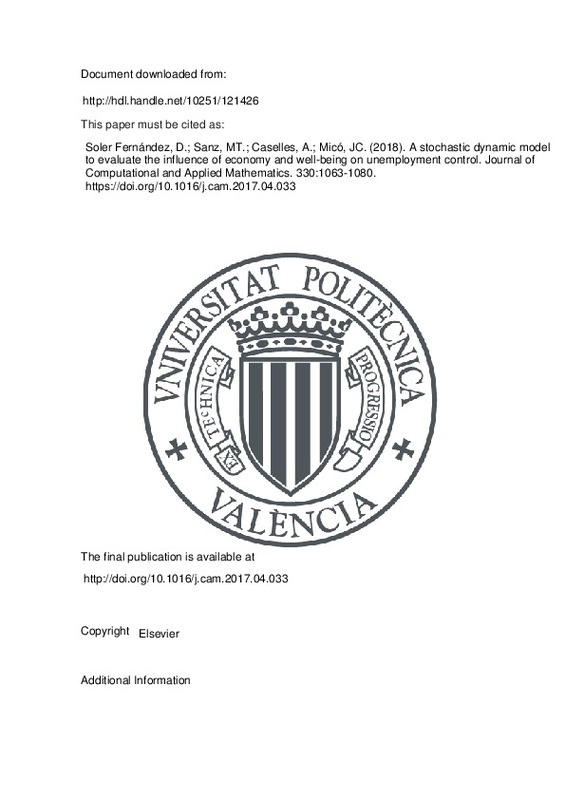JavaScript is disabled for your browser. Some features of this site may not work without it.
Buscar en RiuNet
Listar
Mi cuenta
Estadísticas
Ayuda RiuNet
Admin. UPV
A stochastic dynamic model to evaluate the influence of economy and well-being on unemployment control
Mostrar el registro sencillo del ítem
Ficheros en el ítem
| dc.contributor.author | Soler Fernández, David
|
es_ES |
| dc.contributor.author | Sanz, María T.
|
es_ES |
| dc.contributor.author | Caselles, Antonio
|
es_ES |
| dc.contributor.author | Micó, Joan C.
|
es_ES |
| dc.date.accessioned | 2019-06-01T20:02:17Z | |
| dc.date.available | 2019-06-01T20:02:17Z | |
| dc.date.issued | 2018 | es_ES |
| dc.identifier.issn | 0377-0427 | es_ES |
| dc.identifier.uri | http://hdl.handle.net/10251/121426 | |
| dc.description.abstract | [EN] This paper presents a stochastic dynamic mathematical model to study the evolution of the unemployment rate and other relevant related variables in a country. This model is composed by three basic interrelated subsystems: demographic, economic and wellbeing ones. A key aspect of this model is that it considers three UN well-being variables simultaneously: Human Development Index, Gender Empowerment Index and Gender Differentiation Index. These variables involve key concepts for human development, as Health, Education, Economy and Female Labor. With this model, the most outstanding variables found in the literature in relation with unemployment control can be used to design strategies and scenarios to reduce the unemployment rate in the future. The model has been fitted for the case of Spain in the 2002¿2014 period, the largest one with information about all the variables involved in the model. Finally, several tentative scenarios and strategies have been tested to reduce the unemployment rate in Spain in the horizon of year 2025, and the corresponding forecast evolution of the Gender Differentiation Index, National income per capita, Public debt and the ratio between Public debt and Gross domestic product are shown. | es_ES |
| dc.language | Inglés | es_ES |
| dc.publisher | Elsevier | es_ES |
| dc.relation.ispartof | Journal of Computational and Applied Mathematics | es_ES |
| dc.rights | Reconocimiento - No comercial - Sin obra derivada (by-nc-nd) | es_ES |
| dc.subject | Unemployment rate | es_ES |
| dc.subject | United Nations well-being variables | es_ES |
| dc.subject | Sex/age-structured population dynamics | es_ES |
| dc.subject | Stochastic model | es_ES |
| dc.subject | Forecasting | es_ES |
| dc.subject.classification | MATEMATICA APLICADA | es_ES |
| dc.title | A stochastic dynamic model to evaluate the influence of economy and well-being on unemployment control | es_ES |
| dc.type | Artículo | es_ES |
| dc.identifier.doi | 10.1016/j.cam.2017.04.033 | es_ES |
| dc.rights.accessRights | Abierto | es_ES |
| dc.contributor.affiliation | Universitat Politècnica de València. Departamento de Matemática Aplicada - Departament de Matemàtica Aplicada | es_ES |
| dc.description.bibliographicCitation | Soler Fernández, D.; Sanz, MT.; Caselles, A.; Micó, JC. (2018). A stochastic dynamic model to evaluate the influence of economy and well-being on unemployment control. Journal of Computational and Applied Mathematics. 330:1063-1080. https://doi.org/10.1016/j.cam.2017.04.033 | es_ES |
| dc.description.accrualMethod | S | es_ES |
| dc.relation.publisherversion | http://doi.org/10.1016/j.cam.2017.04.033 | es_ES |
| dc.description.upvformatpinicio | 1063 | es_ES |
| dc.description.upvformatpfin | 1080 | es_ES |
| dc.type.version | info:eu-repo/semantics/publishedVersion | es_ES |
| dc.description.volume | 330 | es_ES |
| dc.relation.pasarela | S\345709 | es_ES |







![[Cerrado]](/themes/UPV/images/candado.png)

